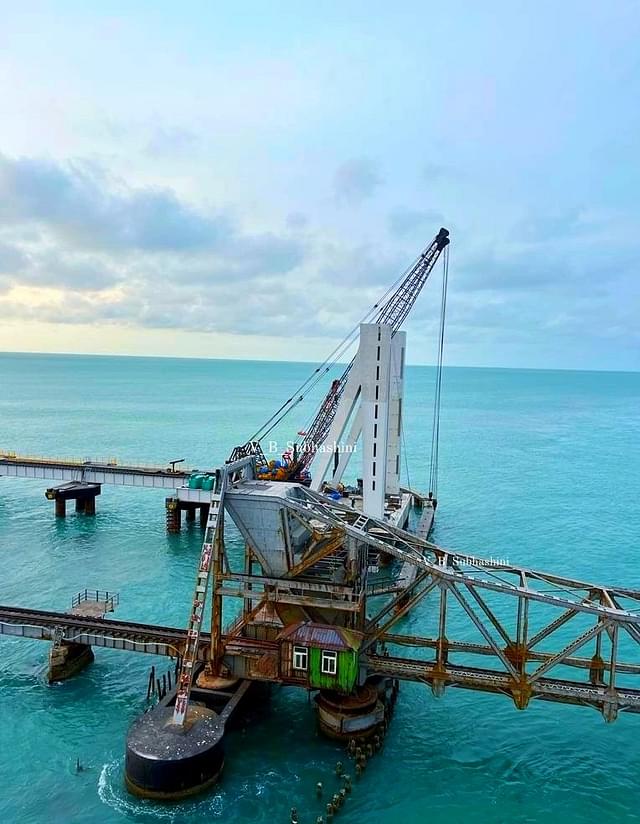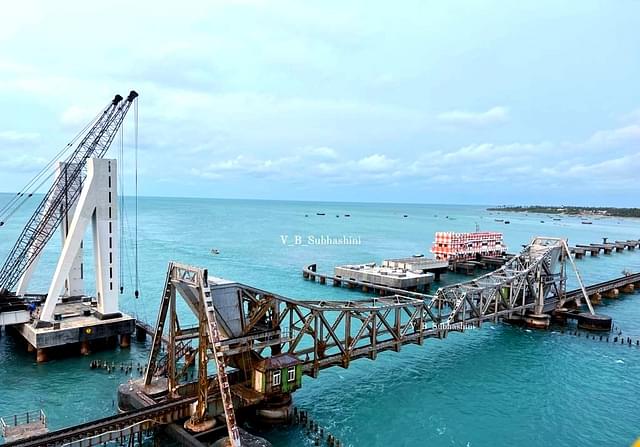The Pamban vertical rail bridge is expected to be operational by February 2024, according to Roop Narayan Sunkar, a member of the Railway Board responsible for infrastructure.
Pamban Bridge is India’s first vertical-lift railway sea bridge, a modern engineering marvel, that promises to redefine connectivity and maritime navigation in the area.
The sea bridge is being executed by Rail Vikas Nigam Limited (RVNL) at a cost of Rs 535 crore.
The new bridge will be around 2.2 km long and will connect Mandapam town in mainland India to Pamban Island and Rameswaram. It will replace the existing century-old iconic structure built during British rule.
Sunkar conducted an inspection of various infrastructure projects in Rameswaram and stated that 90 per cent of the construction on the Pamban vertical rail bridge has been completed.
Despite some initial delays, he expressed satisfaction with the quality of the work.
During his visit to Dhanushkodi, Sunkar also examined the ongoing station redevelopment at Rameswaram railway station. Sunkar emphasised the necessity of replacing the old bridge with a new vertical bridge due to the damage incurred by the former, reports Times Of India.
Regarding the proposed railway line connecting Rameswaram and Dhanushkodi, Sunkar disclosed that the railways have been in communication with the Tamil Nadu government, awaiting their approval and the allocation of land for the project.
He assured that the necessary surveys and preparations had been completed, emphasising the feasibility of the project. The new alignment would run parallel to the existing route, with elevated tracks to withstand the impact of low and high tides.
Sunkar expressed optimism, stating that once the state government gives its approval, work on the Dhanushkodi project will commence promptly.
Additionally, Sunkar pledged to enhance facilities at the Mandapam railway station, which serves as a terminal station during disruptions in traffic on the Pamban bridge.
India’s First Vertical-Lift Railway Sea Bridge — Key Features
The vertical-lift bridge will be 3 metres higher than the existing bridge, with a navigational air clearance of 22 metres above sea level. It will be operated using an electro-mechanical control system interlocked with train control systems.
The new bridge will also feature several other innovative technologies, such as composite sleepers, stainless steel reinforcing, and long-lasting paintwork.
The Pamban railway sea bridge consists of 99 horizontal spans, each measuring 18.3 metres in length, along with a single span of 72.5 metres.
Vertical-Lift Mechanism: The highlight of this project is the vertical-lift mechanism. This mechanism will allow the central section of the bridge to be raised to a near-vertical position, creating an opening for ships to pass through. The bridge is 12.5 metres above sea level. Two ships will cross this bridge simultaneously.
Enhanced Safety: The modernisation of the bridge will include improved safety features, such as advanced signalling and control systems, to prevent accidents and ensure smooth operation.
Reduced Disruption: The vertical-lift feature will significantly reduce the downtime for train and road traffic when ships need to pass underneath. This will have a positive impact on the efficiency and reliability of transportation in the region.


The construction of India’s first vertical-lift railway sea bridge is not just an engineering project; it’s a symbol of progress, connectivity, and the preservation of India’s heritage.
It holds the promise of transforming the region’s transportation landscape, fostering economic growth, and further solidifying Rameswaram’s cultural and religious significance.
This bridge exemplifies the dynamic synergy of tradition and innovation, a hallmark of India’s growth story.


